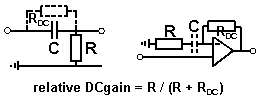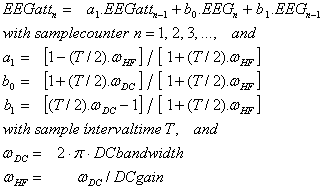Some biosensors produce large DC
offsets that can drive the signal outside the range of both amplifiers
and 16-bit EDF(+). Examples are
respiration sensors or EEG electrodes. Therefore, respiration and EEG
amplifiers usually have a
high-pass filter that rejects the
DC component. However, the DC
component sometimes is essential, for instance when recording respiration for the diagnosis of
Rett syndrome or Fullband
EEG.
In those cases, the DC component can be attenuated rather than
rejected. The DC-attenuated signal then fits in the range of
the amplifiers and EDF(+). The
original Fullband or Respiration signal is then reconstructed by a simple
digital de-attenuator in the review
software. In summary (but check the publication for a
few important details such as initial conditions), it works as follows:
During recording
Attenuate the DC
component by an electronic filter (pick one on the left), or by its digital equivalent (on the right):
Save the DC-attenuated signal in EDF or
EDF+.
Save the applied values of DCgain
and DCbandwidth in the
EDF(+) header.
During review
Read
the values of DCgain and
DCbandwidth.
Read the DC-attenuated signal.
Reconstruct the original
signal, i.e. de-attenuate the
DC component, by the inverse filter:

This
is a valuable add-on for those cases in which either the amplifier
and/or the 16 EDF bits can not accommodate large DC components or very
slow drifts. The method is not
part of the formal EDF or EDF+ specification, so the de-attenuator may
not be implemented in all EDF(+) software. Therefore, the DC-attenuator
should only be applied when absolutely necessary.
Your implementation of both the attenuator and the de-attenuator can be tested by our
DC-attenuated EEG file
and the de-attenuator in our review software Polyman.
Both are on the
download page.


